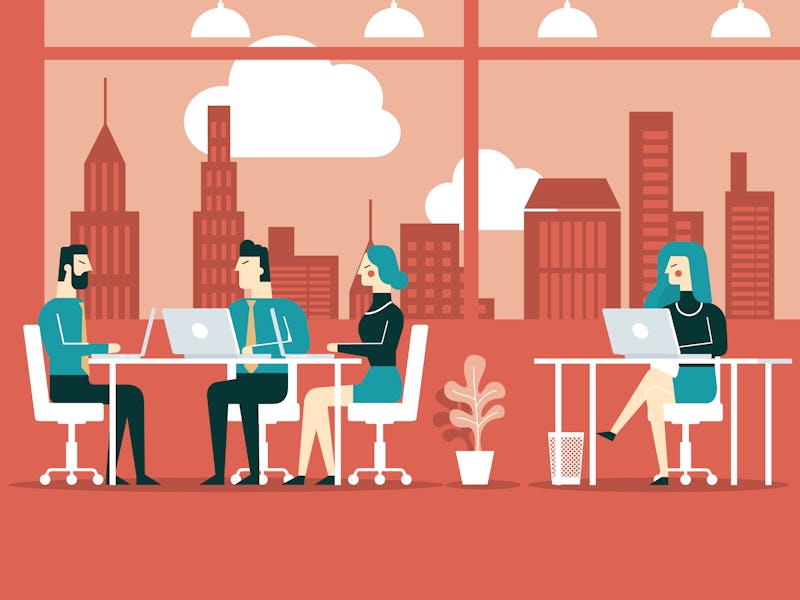Experts reveal 5 predictions for the office of the future
“We spend 90 percent of our time indoors, so we need our buildings to take care of us.”

Work has changed significantly in the past two decades. Even before the introduction of the smartphone and the popularization of laptops, the walls were coming down in offices in an effort to boost collaboration between coworkers. The spread of the open office has had significant impacts on pretty much all aspects of workplaces, leading to the creation of office phone booths and cafe-style spaces that offer refuges for people to think. Coworking spaces have also proliferated to serve the needs of an increasingly mobile workforce.
Over the past two months, Inverse has explored the changes to our workspaces in a series called Office Evolution. In the series, office designers, entrepreneurs, and others share what they believe offices will look like in the coming years. Here are their predictions:
1. Open offices are here to stay, with some tweaks.
Although open offices drive some people nuts, we won’t be quitting them anytime soon. Even the youngest members of the workforce, Generation Z, see their value. Whitney Malone, a 25-year-old designer at Cooper Robertson, said “the open office makes the most sense for collaborative design work.”
That’s not to say that there won’t be changes. Aspects of the maligned cubicle may make a return in the form of panel dividers on desks. “There’ll be some tradeoff between the flexibility of an open office and the cleanliness and privacy of the cubicle,” said Verity Sylvester, co-founder of office furniture company Branch.
2. Expect even more office phone booths.
One result (consequence?) of open offices has been increased noise, primarily chatter from coworkers talking on the phone. To remedy this issue, in 2010 Framery introduced the first office phone booths where people could make calls without disturbing others or for quick bursts of increased focus.
Offices may be less dense in the future, but Framery and other booth makers don’t see that as a threat to their businesses. In fact, they expect it to drive demand for their products, as people will be on the phone or video chat with their work-from-home colleagues more often. To respond to the needs for better hygiene, booth makers will incorporate antimicrobial surfaces and HEPA filters, while offices will provide sanitizers and wipes to keep booths clean.
“We spend 90 percent of our time indoors, so we need our buildings to take care of us.”
3. Water cooler chats will remain a staple of offices.
The water cooler, introduced more than 100 years ago, has been the center of office life for several decades now. The area around the water cooler serves not only as a place for workers to refresh, but also chat about TV, planned projects, or even come up with million-dollar ideas. The water cooler now comes in many forms, from a coffee machine to sparkling water or even a kombucha dispenser. But what happens when fewer people are physically in the office?
Several companies have tried to figure it out, from Revelry’s #watercooler Slack channel or Zoom’s “Zoom roulette,” a large video conference that is separated into smaller groups to “create virtual water cooler experiences.”
This type of virtual chat may work for some companies, but face-to-face human interaction will always be sought after. So the water cooler may take a different shape in the immediate future — such as the contactless machines commonly found in airports — but it’s clear it will retain its place for impromptu office chatter.
4. Snacks and food will be a perk no matter where employees are.
Thanks in part to the coffee culture created by Starbucks, office cafeterias began offering a healthier selection of food while also serving as an alternative to desks as a place to get work done. Meanwhile, tech companies led by Google started competing for talent by curating a selection of interesting snacks available to employees for free.
It’s unclear how cafeterias will look in the immediate future, but it’s likely meal times may be staggered so these rooms are less dense. But people may not need to leave their desks for lunch; by using internal apps, boxed meals can be brought straight to them. Work-from-home employees won’t miss out on office offerings, either. Expect more employers to offer snack boxes that are delivered directly to employees’ homes.
5. Monitoring will lead to better air and lighting in offices.
Our offices account for a large chunk of the world’s energy usage, so finding ways to be more efficient is necessary to fight climate change. Two ways to do that while also making the lives of office workers better is to improve the air quality and lighting within our workplaces.
Thanks in part to increasingly cheaper monitoring tools, companies can discover air issues and electrical inefficiencies and fix them. These improvements have a domino effect, from reducing energy consumption to increasing demand for more sustainable materials.
“We’ve become an indoor species,” said Heidi Creighton, associate principal of the sustainability group at the Los Angeles office of Buro Happold, a global engineering consulting firm. “We spend 90 percent of our time indoors, so we need our buildings to take care of us.”